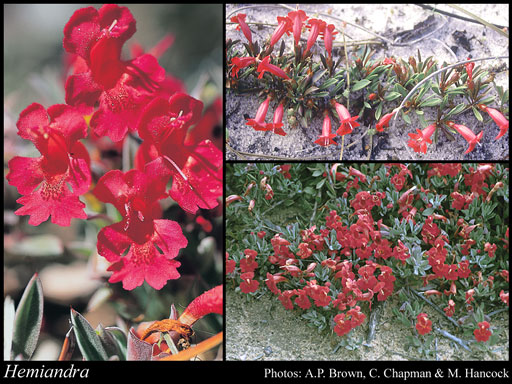- Reference
- Prodr.Fl.Nov.Holland. 502 (1810)
- Name Status
- Current







Scientific Description
Common name. Snakebushes. Family Lamiaceae.
Habit and leaf form. Rigid shrubs; bearing essential oils. Plants unarmed. Leaves cauline. Plants with neither basal nor terminal concentrations of leaves. Young stems usually tetragonal. To 0.1–1 m high. Leptocaul. Leaves small to medium-sized; opposite; leathery; sessile; aromatic, or foetid, or without marked odour; simple; epulvinate. Leaf blades entire; flat, or rolled; narrowly oblong, or obtriangular, or obtrullate (narrowly); one-veined, or pinnately veined; cross-venulate; cordate to cuneate at the base, or rounded at the base. Mature leaf blades adaxially glabrous, or scabrous. Leaves without stipules. Leaf blade margins entire; flat, or revolute. Leaves without a persistent basal meristem. Leaf anatomy. Hairs present; glandular hairs present. Urticating hairs absent. Stem anatomy. Secondary thickening developing from a conventional cambial ring.
Reproductive type, pollination. Fertile flowers hermaphrodite. Unisexual flowers absent. Plants hermaphrodite. Plants heterostylous. Entomophilous, or ornithophilous; usually via hymenoptera, or via lepidoptera, or via diptera.
Inflorescence and flower features. Flowers solitary, or aggregated in ‘inflorescences’; pedicellate; 2- bracteolate. Bracteoles not adnate to the receptacle. Flowers medium-sized; very irregular; zygomorphic; cyclic; tetracyclic. Floral receptacle developing a gynophore, or with neither androphore nor gynophore. Free hypanthium absent. Perianth with distinct calyx and corolla; 4–10; 2 -whorled; isomerous, or anisomerous. Calyx present; 5, or 3 (sometimes, ostensibly); 1 -whorled; gamosepalous; blunt-lobed, or toothed; imbricate, or open in bud; exceeded by the corolla; campanulate, or funnel-shaped, or tubular; regular, or bilabiate; non-fleshy; persistent; accrescent; with the median member posterior. Calyx lobes ovate. Corolla present; disguisedly 5; 1 -whorled; gamopetalous; blunt-lobed; imbricate; bilabiate (the upper lip short, erect and broadly 2-lobed, the lower lip longer, spreading, 3-lobed with the middle one itself often 2-lobed); hairy abaxially; with contrasting markings; white, or pink, or purple (with dark spots in the throat). Corolla members bilobed (middle lobe), or entire (side lobes crenate to laciniate). Androecium present. Fertile stamens present. Androecial members definite in number. Androecium 4. Androecial members adnate; markedly unequal; free of one another; 1 -whorled. Androecium exclusively of fertile stamens. Stamens 4. Staminal insertion midway down the corolla tube, or in the throat of the corolla tube. Stamens becoming exserted; didynamous, or not didynamous, not tetradynamous; all more or less similar in shape; reduced in number relative to the adjacent perianth; fertile stamens representing the posterior-lateral pair and the anterior-lateral pair; oppositisepalous; all alternating with the corolla members. Filaments filiform. Anthers separate from one another; dorsifixed; versatile, or non-versatile; dehiscing via longitudinal slits; introrse; unilocular (apparently); tetrasporangiate; appendaged. Pollen shed as single grains. Fertile gynoecium present. Gynoecium 2 carpelled (the carpels deeply lobed to mimic G4). The pistil 4 celled. Carpels reduced in number relative to the perianth. Gynoecium syncarpous; synstylovarious to eu-syncarpous; superior. Ovary plurilocular; 2 locular (originally), or 4 locular (by intrusions of the ovary wall constituting ‘false septa’). Locules secondarily divided by ‘false septa’. Gynoecium median; stylate. Styles 1; simple; from a depression at the top of the ovary; apical; much longer than the ovary at anthesis; becoming exserted. Stigmas 2; 2 - lobed. Placentation basal. Ovules 2 per locule, or 1 per locule (two per original loculus, but one per locellus); ascending; apotropous; non-arillate; anatropous, or hemianatropous.
Fruit and seed features. Fruit non-fleshy, or fleshy; a schizocarp. Mericarps (2–)4; comprising nutlets. Seeds endospermic to non-endospermic. Embryo well differentiated. Cotyledons 2. Embryo straight.
Special features. The flowering nodes separated by extended internodes. 1 flowers subtended by each floral leaf. Calyx limb 3 lobed, or 5 lobed. Upper lip of calyx when bilabiate, entire, or lobed; when segmented, 3 lobed. Lower lip of calyx lobed; 2 lobed. Corolla tube exceeding the calyx; straight, or curved. The upper lip of the corolla incorporating 2 members, the lower 3; (posterior, adaxial) lip of the corolla bilobed. Lower (abaxial) lip of the corolla 3 lobed (the middle one often itself bilobed). Stamens ascending. The appendages of the fertile anthers the obsolete cell of the anther linear (or tooth-like).
Geography, cytology, number of species. Native of Australia. Endemic to Australia. Australian states and territories: Western Australia. A genus of 8 species; 8 species in Western Australia; 8 endemic to Western Australia.
Etymology. From the Greek for "half" and "man, stamen"; the anthers are one-celled, the lower end of the connective being reduced to a tongue.
Taxonomic Literature
- Wheeler, Judy; Marchant, Neville; Lewington, Margaret; Graham, Lorraine 2002. Flora of the south west, Bunbury, Augusta, Denmark. Volume 2, dicotyledons. Australian Biological Resources Study.. Canberra..
- Marchant, N. G.; Wheeler, J. R.; Rye, B. L.; Bennett, E. M.; Lander, N. S.; Macfarlane, T. D.; Western Australian Herbarium 1987. Flora of the Perth region. Part one. Western Australian Herbarium.. [Perth]..
- Blackall, William E.; Grieve, Brian J. 1981. How to know Western Australian wildflowers : a key to the flora of the extratropical regions of Western Australia. Part IIIB, (Epacridaceae-Lamiaceae). University of W.A. Press.. [Perth]..